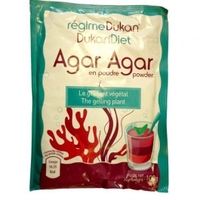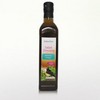-
Home
-
Contributors
-
International
-
Account
-
Information
More From Contributor
- but ...

Dukan Agar Agar 100g
of algae or seaweed from which agar is derived are sometimes called Ceylon moss or Jaffna moss. Gracilaria lichenoides is specifically referred to as agal-agal or Ceylon agar.What makes it so healthy?The main difference between gelatine and Agar Agar lies in the latter's slimming qualities. When analysed in equal quantities, the proportion of calories in gelatin is considerably greater than that in Agar Agar. In addition, since 80% of Agar-agar consists of highly absorbent fibres, these algae swell once ingested and generate a feeling of satisfaction and satiety. Once in the intestinal tract, they capture and eliminate a small proportion of fats and sugars.
This page now acts as a permanent archive for this product. Add more information using the comments box below to ensure it can still be found by future generations.
Use our search facility to see if it is available from an alternative contributor.
- Availability: Out Of Stock
- Supplier: The Health Bay
- SKU: DUK-015
Product Description
Agar-agar is a natural vegetable substitute for gelatin. White & semi-translucent, Agar-agar is sold in packages as washed & dried strips or in powdered form. It can be used to make jellies, puddings, & custards. For making jelly, boil the agar-agar in a pot of water until the solids dissolve. Sweeteners, flavourings, colourings, fruit or vegetables can then be added. The liquid is then poured into moulds to be served as desserts & vegetable aspics, or incorporated with other desserts, such as a jelly layer in a cake. Agar-agar is Approx. 80% fibre, so it can serve as an intestinal regulator. A little history... The word "agar" comes from the Malay word agar-agar (meaning jelly). It is also known as kanten, China grass, or Japanese isinglass. The various species of algae or seaweed from which agar is derived are sometimes called Ceylon moss or Jaffna moss. Gracilaria lichenoides is specifically referred to as agal-agal or Ceylon agar. What makes it so healthy? The main difference between gelatine & Agar Agar lies in the latter's slimming qualities. When analysed in equal quantities, the proportion of calories in gelatin is considerably greater than that in Agar Agar. In addition, since 80% of Agar-agar consists of highly absorbent fibres, these algae swell once ingested & generate a feeling of satisfaction & satiety. Once in the intestinal tract, they capture & eliminate a small proportion of fats & sugars.
Reviews/Comments
Add New
Intelligent Comparison
We couldn't find anything!
Perhaps this product's unique.... Or perhaps we are still looking for comparisons!
Click to bump this page and we'll hurry up.
Price History
We couldn't find any historical pricing!
Vouchers
Do you know a voucher code for this product or supplier? Add it to Insights for others to use.
Jargon Buster
Supplier Information
Free delivery for orders of £40 or more.


 United Kingdom
United Kingdom
 France
France
 Germany
Germany
 Netherlands
Netherlands
 Sweden
Sweden
 USA
USA
 Italy
Italy
 Spain
Spain



 Denmark
Denmark